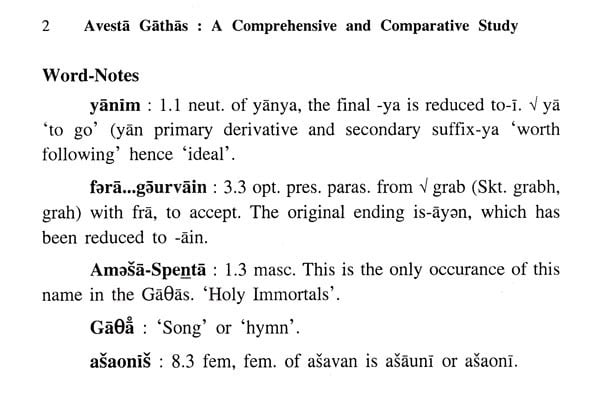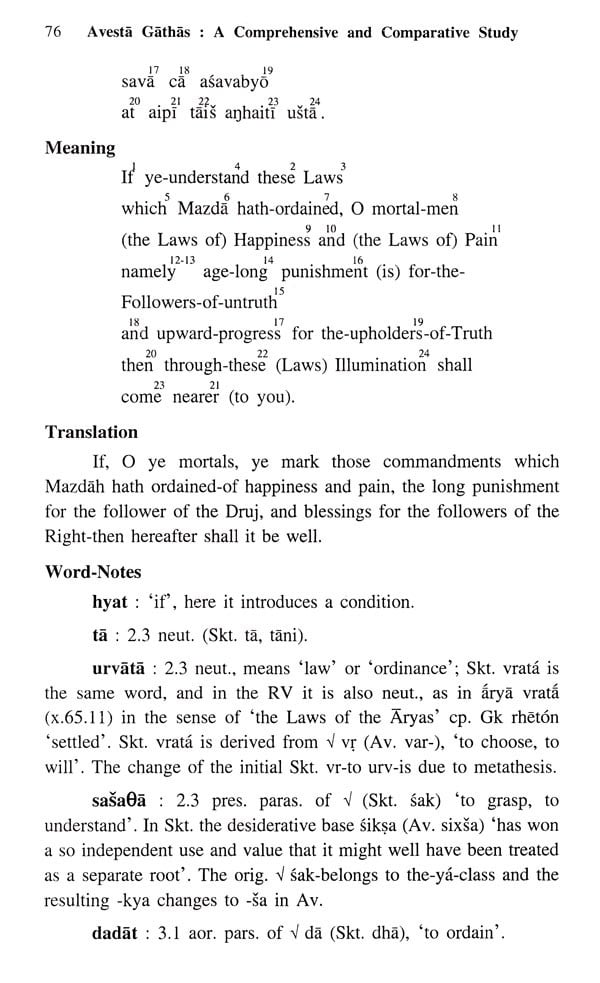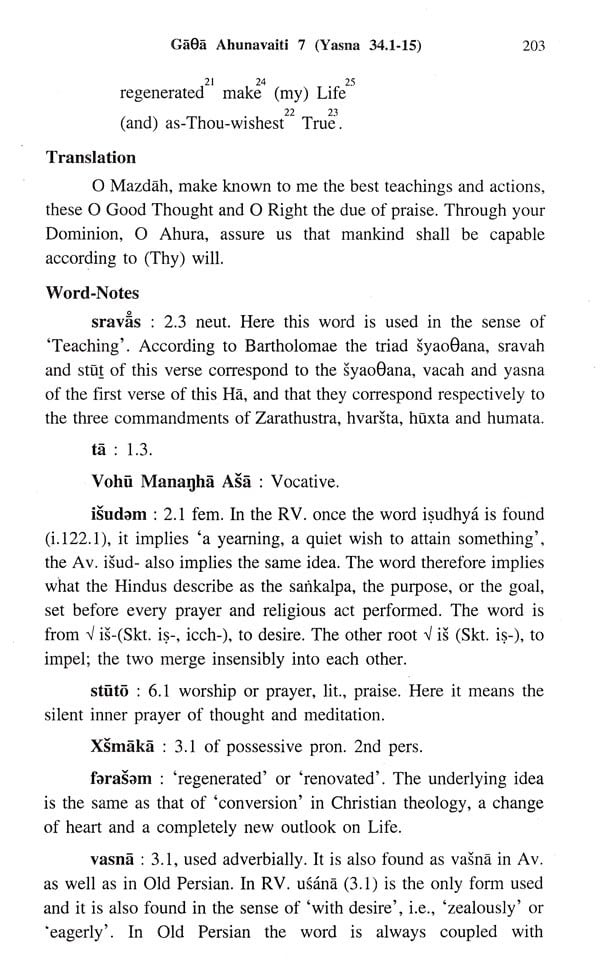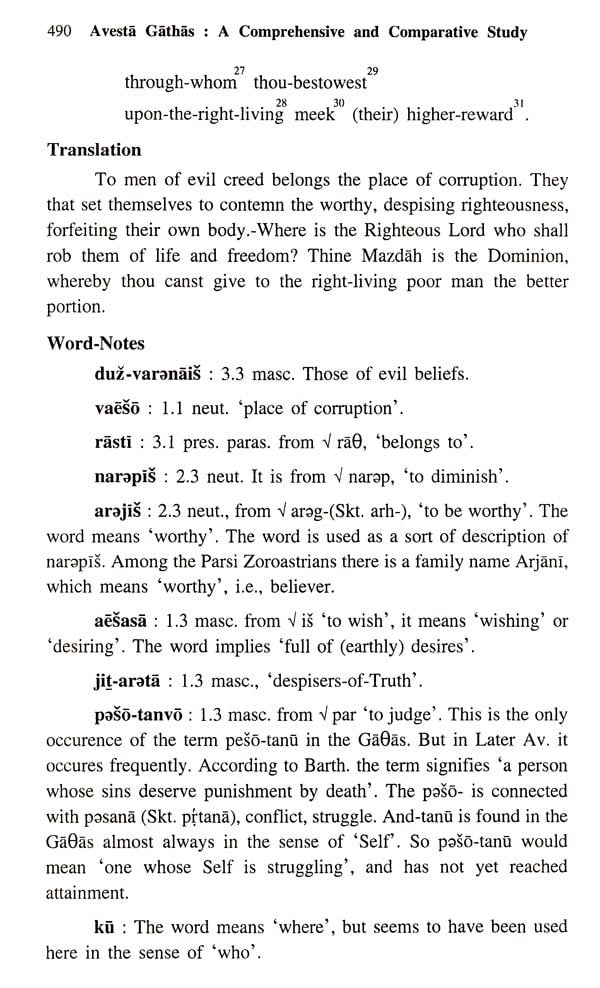
Avesta Gathas A Comprehensive and Comparative Study
Book Specification
| Item Code: | UAC448 |
| Author: | Sharda Chaturvedi |
| Publisher: | Sampurnanand Sanskrit University |
| Language: | Vedic Sanskrit with Transliteration and Translation |
| Edition: | 2010 |
| ISBN: | 817270240X |
| Pages: | 510 |
| Cover: | HARDCOVER |
| Other Details | 10.00X6.50 inch Depth |
| Weight | 950 gm |
Book Description
After the establishment of the Asiatic Society. European Scholars began to learn about Sanskrit language. The study of Indo European languages including the science of language or philology and comparative and historical linguistics began. In this context they began study of Pali, Prakrit and Apabramsa languages. One branch of Apabhramsa is related to Paisachi, Pushto and eastern Iranian languages. In the Buddhist period Afghanistan was also a part of India. Panini, the great grammarian belonged to Afghanistan. Yäska and Patañjali mentioned in their Nirukta and Mahabhäsya that Sanskrit was a conversational language in Kamboja savatir gatikarmā kambojesu'. Before Panini, in the Mahabharata period the mother of Duryodhana sister of Sakuni, the king of Gandhara (Afghanistan), was born there. Bactria, the eastern part of Iran was connected to Afghanistan. Azerbaijan (< Aryabijani) the birth place of Zarathustra, is connected to Bactria. This was settled by Medas before the 8th Cent. B.C., and became a province in the Persian empire including Caucasus and Caspian coast. Bactrian languages were influenced by Vedic Sanskrit.
The Avesta, the religious book of Persians, was composed in Bactrian language, hence influenced by Vedic Sanskrit. It is so intimate to Vedic language that it seems a kind of Prakrit of Vedic language. Thousands of years ago, a new race was meant to take over leadership of the Western World. It was constituted in an isolated valley of the Caucasus mountains, by Manu Vaivasvata, named Yima (known in Zoroastrian scriptures as Yima Vivanghvan, or later termed king Jamshed). The race was designated Aryan (= 'of noble lineage') to supercede the negroid and the Mongolian races.
This root-race when mature, sent out its off-shoots to various parts of the world (Ancient Egypt, Iran, Greece etc.) to start a new, civilization. The Indian base was Äryävarta, while Persian one was "Iran vez' (= Aryanam Vaezo). King Jamshed founded the dynesty known in Iranian history as "peshdadyan' (=Pertaining to the first primary law of Divine Worship). By religion, they were known as Mazda-yasni (Worshippers of the omniscient Lord--as opposed to idol-worshipping persons). While Vyasa was the world teacher, he expounded the Vedas in Sanskrit language. The Iranian counterpart had A vesta, meaning "The message revealed by God'.
Aryans migrated from India many times. Evidence of this is found in Vedic and Puranic literature about the migrations of Aryans. The first migration commenced in the period of Vaivasvata Manu, His son Nabhanediştha ruled there in Shakasthana > Seistan. This name exists in Avestà as 'Nabanazdisht'. One race of Aryans migrated from Sumeru to Meru (see Nundolal Dey's "The Geographical Dictionary of Ancient and Mediaeval India).
Four other races moved from India to Western countries. The fifth race of Gypsies moved from Rajasthan, Sindh, Punjab and Afghanistan to Iran, Egypt and Western countries. According to the Mahabharata there were four castes of Iranian Magas known as Brahmana, Ksatriya, Vaisya and Sūdra are in India.
Western scholars think "The sub-race that entered Northern India (land of the Indus) was termed as the Hindus. In Avestä the Sindhu province had been called (in Sraoša Yast) 'Hindvo'. Another branch was established in Egypt (The then white race) and Hermes was their teacher. Hermetic mysteries still remain as relics of their religious beliefs-Aryan in character. The third migration came to Iran (Persia was its later name that it took when a province Pārs (= Färs) in the west was dominant, during the Achaemenian dynasty). Meanwhile the message of Zarathushtra was preached in the East, what is known as Bactria; the prophet is often called the Bactrian sage. This part is also known as Balkha'.
Indian Aryans did not migrate from Asia minor. It was misinterpreted that Aryans migrated from outside to India. 'S' letter of Sanskrit changes into 'H' of Western languages. Such as Sindhu > Hindu, Asura > Ahura etc. But never Hindu can be changed into Sindhu and Ahura to Asura. Sanskrit words were inserted in European languages but not words of Turkish or Persians.
It is an occasion of pleasure and gratification to commend this erudite work 'Avestä Gäthäs : A Comprehensive and Comparative Study’. Avestan is a quite significant member of the Indo-European family of speeches. It is well known that Avestă Gathas are the oldest part of Avesta, which are parallel to Vedic Sanskrit. Great ideals admired in Sanskrit scriptures were discoverable in Avestă. The Gathas are chants. These are the supreme source of Zorostrean religion as well as spiritual strength, like the Vedas.
The present work of Prof. Sharda Chaturvedi is quite toilsome indeed. The author transliterated all the five Gäthäs of Avesta in Devanagari as well as in Roman with its meaning and English translation. The comprehensive word-note of each word has made the book more fruitful. The impact and implicaiton of Dr. Chaturvedi's work will be far flung for it is an historico comparative comprehensive work of Avestä Gathäs in the real sense of the nomenclature marshalling with fuller comparative evidence. Added to this, the system of giving numbers to the words is very thoughtful and useful.
I hope this learned work will find a notable place in the field of linguistics. I am sure that it will receive a great deal of appreciation from the scholars of the field. I wish the scholar a great intellectual life.
I extend my thanks to Prof. Narendranath Pandey, Director, Publication Institute of Sampurnanand Sanskrit University and his whole team who have taken extra care in the printing of this book.
**Contents and Sample Pages**
















